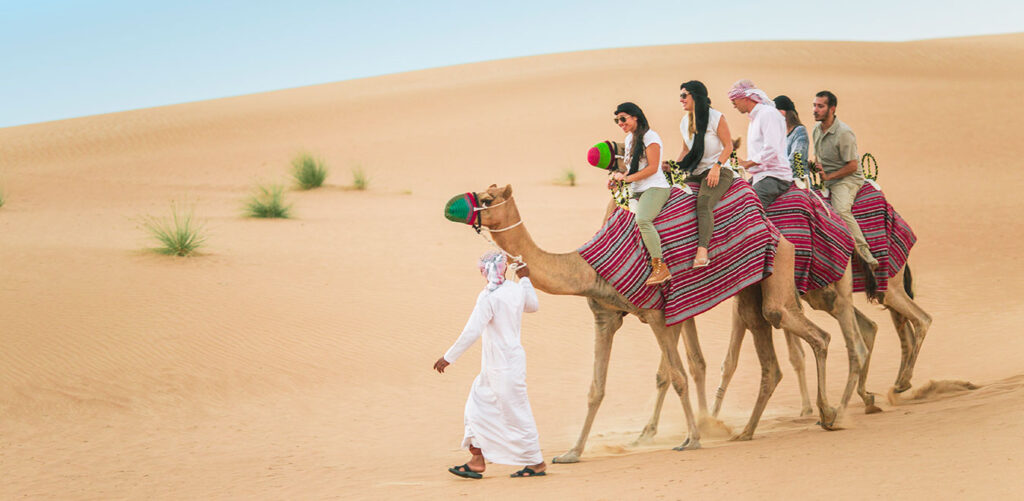Best Desert Safari on Camel Ride
Introduction Embarking on a Desert Safari adventure on a quad bike is a thrilling experience that allows you to immerse yourself in the beauty and grandeur of the arid landscapes. Here’s a step-by-step guide to help you make the most of this exhilarating journey: Preparation and Safety Briefing Before setting out on your quad bike adventure, it’s crucial to attend a safety briefing provided by experienced guides. They will equip you with essential information about operating the quad bike, safety precautions, and guidelines for navigating the Desert Safari. Don’t forget to wear appropriate clothing, including comfortable clothing, closed-toe shoes, and a helmet for protection. Arrival and Registration Arrive at the designated meeting point for your quad bike adventure. Check-in with the staff and complete any necessary paperwork or registration forms. This is where you’ll provide your contact details and sign any liability waivers. Introduction to Guides Meet the experienced guides who will be leading your quad bike adventure. These guides are trained and knowledgeable about the terrain, safety protocols, and the operation of the quad bikes. Safety Briefing Gather with the other participants and guides for a comprehensive safety briefing. This is a crucial step to ensure everyone’s well-being during the adventure. During the safety briefing, the guides will cover the following points: Introduction to Quad Bikes: The guides will introduce the quad bikes, explaining their basic features, controls, and how to properly operate them. Safety Precautions: You will receive detailed instructions on safety precautions, including how to sit on the quad bike, how to hold the handlebars, and how to properly accelerate and brake. Helmet and Protective Gear: Emphasize the importance of wearing a helmet at all times during the adventure. Guides will explain how to properly secure the helmet and provide any additional protective gear if required. Desert Terrain Guidelines: The guides will discuss the type of terrain you’ll encounter during the adventure, such as sand dunes, rocky paths, and open areas. They’ll provide guidance on how to navigate each type of terrain safely. Speed Limits: Discuss the recommended speed limits for different sections of the adventure. To avoid mishaps, emphasize the necessity of adhering to these restrictions. Group Riding Etiquette: If you’re riding in a group, the guides will explain the proper distance to maintain between quad bikes to ensure safety while riding in a formation. Emergency Procedures: Brief participants on what to do in case of an emergency, such as breakdowns, injuries, or getting separated from the group. Provide information about communication methods to contact the guides or support staff. Questions and Clarifications After the safety briefing, guides will open the floor for any questions or clarifications participants may have. This is the time to address any concerns and ensure that everyone fully understands the safety guidelines and procedures. Gear Up After the safety briefing, participants will be provided with appropriate gear, which may include helmets, goggles, and any other necessary protective clothing. Make sure to wear comfortable clothing that covers your arms and legs, closed-toe shoes, and the provided safety gear. Practice and Familiarization Before setting out on the adventure, you may have a brief practice session in a controlled area to get familiar with operating the quad bike. Guides might offer hands-on assistance and tips for controlling the vehicle effectively. Embark on the Adventure With the safety briefing completed and gear in place, you’re ready to embark on your quad bike adventure. Follow the guides’ instructions, adhere to safety guidelines, and enjoy the thrilling experience while staying safe. By following these steps and paying close attention to the safety briefing, you can ensure a fun and secure quad bike adventure through the desert terrain. Getting Acquainted with the Quad Bike Learn how to use the quad bike’s controls and features. Practice operating the throttle, brakes, and steering to build confidence in handling the vehicle. Your guide will be there to assist and answer any questions you may have. Introduction and Safety Begin by meeting your guide, who will introduce you to the quad bike and provide important safety instructions. Wear appropriate safety gear such as a helmet, gloves, long-sleeved shirt, pants, and closed-toed shoes. Overview of Controls and Features Stand beside the quad bike and have your guide walk you through the various controls and features. These may include the throttle, brakes, steering, ignition switch, headlights, and indicators. Mounting and Dismounting Practice getting on and off the quad bike. Approach the vehicle from the left side, hold onto the handlebars, and swing your leg over the seat. Basic Controls Familiarization Sit on the quad bike and get comfortable. Your guide will explain the basic controls: Throttle: The right handlebar usually has a twist grip for controlling the speed. Practice twisting it gently to get a feel for the throttle response. Brakes: Locate the brake levers on the handlebars. The front brake is controlled by the right lever, and the rear brake is controlled by the left lever. Steering: Hold onto the handlebars and practice turning them gently to the left and right. Engine Start and Stop Learn how to start the engine by turning the ignition key or pressing the start button. Your tour guide will accompany you through the steps. Practice starting the engine and then turning it off. Shifting Gears (if applicable) If the quad bike has gears, your guide will explain the gear shifting process. This usually involves a foot pedal or a hand lever. Practice shifting through the gears while the quad bike is stationary. Slow Maneuvering Start the quad bike and practice moving at a slow speed in an open area. Gently apply the throttle and use the brakes to control your speed. Practice turning the handlebars smoothly to make gradual turns. Braking Practice Find a safe space and practice braking. Start by applying the rear brake only, and then practice using both brakes together for controlled stops. Acceleration and Speed Control Gradually increase your speed while practicing throttle control. Get a feel for



